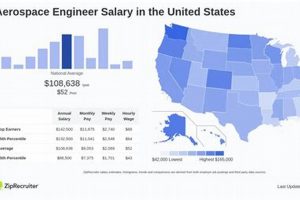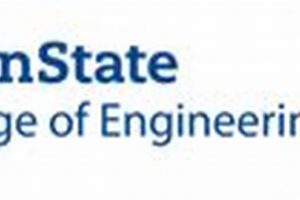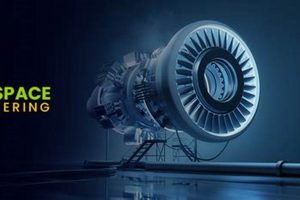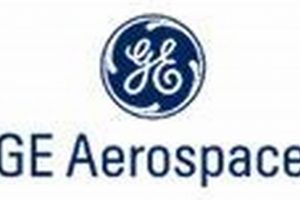Professionals in Australia who design, develop, test, and oversee the manufacturing of aircraft, spacecraft, and related systems form a critical sector within the nation’s technological landscape. These individuals apply engineering principles and scientific knowledge to solve complex problems associated with flight and space exploration. Their work encompasses a broad range of activities, from conceptualizing novel aerial vehicles to improving the efficiency and safety of existing aircraft.
Their contributions are vital to Australia’s defense capabilities, commercial aviation industry, and research endeavors in space science and technology. Historically, these experts have played a significant role in adapting foreign aircraft designs to Australian conditions and developing unique solutions for remote area operations. The expertise cultivated within this field supports national economic growth through innovation, technological advancement, and the creation of high-skilled employment opportunities.
The following sections will explore the educational pathways, core competencies, specific projects, and future prospects of engineering professionals working in aviation and space-related fields within the Australian context, highlighting the multifaceted nature of their contributions to the nation.
Guidance for Aspiring Professionals
The following outlines practical advice distilled from experienced professionals in the field, aimed at those pursuing a career in aerospace engineering within Australia.
Tip 1: Focus on Foundational STEM Skills: A strong understanding of mathematics, physics, and computer science is paramount. Seek opportunities to deepen knowledge in these areas through advanced coursework and independent study. For instance, mastering computational fluid dynamics software is crucial for aerodynamic analysis.
Tip 2: Prioritize Practical Experience: Seek internships or research assistant positions within aerospace companies or university laboratories. Hands-on experience, such as contributing to a drone design project or assisting with wind tunnel testing, provides invaluable insights and skills.
Tip 3: Tailor Education to Specific Interests: Aerospace engineering encompasses various specializations, including aerodynamics, propulsion, structures, and control systems. Identifying a specific area of interest early and focusing studies accordingly, such as specializing in composite materials for lightweight aircraft structures, can enhance career prospects.
Tip 4: Cultivate Effective Communication Skills: Aerospace projects often involve multidisciplinary teams. The ability to clearly and concisely communicate technical information, both verbally and in writing, is essential. Practice presenting technical findings and writing comprehensive reports.
Tip 5: Stay Abreast of Industry Developments: The aerospace sector is rapidly evolving. Continuously monitor industry publications, attend conferences, and engage with professional organizations to stay informed about the latest technological advancements and emerging trends, such as the development of sustainable aviation fuels or advancements in autonomous flight systems.
Tip 6: Develop Systems Thinking: Aerospace engineering requires understanding how individual components interact within complex systems. Cultivate the ability to analyze problems from a holistic perspective and consider the impact of design choices on overall system performance.
Tip 7: Embrace Continuous Learning: Obtain further education. Obtain further education. The pursuit of advanced degrees or specialized certifications relevant to aerospace may improve career prospects.
Adhering to these principles can significantly increase the likelihood of a successful career within Australia’s aerospace sector. These guidelines promote skill acquisition and professional development.
The subsequent sections will address the challenges and opportunities present in the Australian aerospace engineering landscape, providing a comprehensive overview of the field.
1. Qualifications & Accreditation
The formal qualifications and accreditation processes that Australian aerospace engineers undergo are paramount to ensuring professional competence, upholding safety standards, and driving innovation within the industry. These mechanisms validate the knowledge, skills, and ethical conduct of practitioners, thereby safeguarding public trust and facilitating international recognition.
- Educational Foundation
A foundational requirement is the completion of a four-year Bachelor of Engineering degree, typically specializing in aerospace, aeronautical, or a closely related engineering discipline, from an Australian university accredited by Engineers Australia. This ensures a standardized curriculum covering core engineering principles such as aerodynamics, propulsion, structural analysis, and control systems. For example, graduates from the University of Sydney’s aerospace engineering program must demonstrate proficiency in these areas to successfully complete their degree.
- Professional Accreditation
Upon graduation, engineers can pursue professional accreditation with Engineers Australia, the country’s peak body for engineers. This involves demonstrating practical experience and competence through a formal assessment process. Obtaining Chartered Professional Engineer (CPEng) status signifies a high level of expertise and commitment to ethical conduct. Many employers in the aerospace sector require or strongly prefer candidates with CPEng accreditation, ensuring adherence to industry best practices and regulatory requirements.
- Continuing Professional Development (CPD)
Maintaining professional competence requires ongoing learning and development throughout an engineer’s career. Engineers Australia mandates that Chartered Engineers undertake a minimum number of CPD hours each year, encompassing activities such as attending conferences, completing training courses, and participating in industry research. This ensures that engineers remain up-to-date with the latest technological advancements and regulatory changes, such as new aviation safety standards or developments in sustainable aviation technologies.
- Recognition of Overseas Qualifications
For engineers who obtained their qualifications outside of Australia, Engineers Australia provides a process for assessing and recognizing international engineering degrees. This pathway involves demonstrating that the overseas qualifications are equivalent to Australian standards. Successfully completing this assessment allows internationally trained engineers to seek professional accreditation and contribute their skills to the Australian aerospace sector, filling critical skill gaps in specialized areas such as advanced composite materials or satellite systems engineering.
These facets of qualifications and accreditation are intrinsically linked to the overall quality and global competitiveness of Australian aerospace engineering. By upholding rigorous standards and promoting continuous professional development, the industry ensures that its workforce possesses the necessary expertise to address complex challenges and drive future innovation. This robust framework provides a strong foundation for the sector’s continued growth and contribution to the Australian economy.
2. Research & Development
The advancement of the aerospace sector in Australia is fundamentally dependent on the research and development activities undertaken by its engineering workforce. These activities serve as the engine driving innovation, leading to improvements in aircraft performance, safety, and environmental sustainability. The efforts of engineers in this domain directly impact the competitiveness of the Australian aerospace industry on a global scale. For instance, ongoing research into hypersonic flight at universities and government research facilities has the potential to revolutionize air travel and defense capabilities. This research requires specialized engineers with expertise in aerodynamics, materials science, and propulsion systems, directly linking their skills to the future of flight technology.
Aerospace engineers involved in R&D engage in a spectrum of activities, ranging from theoretical modeling and simulation to experimental testing and prototype development. They may be tasked with designing and analyzing novel aircraft configurations, developing advanced composite materials for lightweight structures, or creating more efficient and environmentally friendly propulsion systems. A practical example is the development of advanced drone technologies for agricultural applications. Engineers research optimal drone designs, sensor integration, and data processing algorithms to improve crop monitoring and resource management. This research not only benefits the agricultural sector but also fosters technological advancements that can be applied to other areas of aerospace engineering.
In conclusion, research and development is a critical component of the Australian aerospace engineering landscape. It empowers engineers to push the boundaries of existing technologies, creating new opportunities and driving economic growth. While challenges exist in securing funding and attracting top talent, the continued investment in R&D is essential for Australia to maintain a competitive edge in the global aerospace market. The expertise and ingenuity of these engineers are central to realizing the potential of emerging technologies and addressing the future challenges of the aviation and space industries.
3. Defense Industry Support
The Australian defense industry relies heavily on the specialized skills and knowledge of its aerospace engineering workforce. This support encompasses a wide array of activities, from designing and maintaining military aircraft to developing advanced defense systems. These contributions are crucial for ensuring national security and maintaining a technologically advanced defense force.
- Aircraft Design and Modification
Aerospace engineers are instrumental in the design, development, and modification of military aircraft within Australia. This includes adapting existing aircraft platforms to meet specific operational requirements, integrating new technologies, and ensuring compliance with stringent safety standards. For example, engineers might be involved in modifying a fleet of transport aircraft to enhance their cargo capacity or incorporating advanced surveillance equipment into maritime patrol aircraft. These modifications are essential for maintaining the effectiveness of the Australian Defence Force (ADF) and adapting to evolving security threats.
- Maintenance and Sustainment
The ongoing maintenance and sustainment of military aircraft fleets is another critical area where aerospace engineers contribute. This involves conducting structural inspections, performing repairs, and implementing upgrades to extend the lifespan and operational readiness of aircraft. Engineers ensure that maintenance programs adhere to rigorous quality control standards and regulatory requirements. This critical work guarantees the airworthiness of military assets and reduces downtime, thereby supporting the ADF’s ability to respond to operational demands effectively.
- Systems Integration
Aerospace engineers play a vital role in integrating complex systems into military aircraft and related defense platforms. This includes integrating sensors, communication systems, weapons systems, and electronic warfare capabilities. They ensure that these systems operate seamlessly together and are compatible with existing aircraft infrastructure. For instance, engineers may be involved in integrating a new radar system into a fighter aircraft or developing a secure communication network for unmanned aerial vehicles (UAVs). These integration efforts enhance the overall capabilities of the ADF and improve situational awareness during military operations.
- Research and Development
The defense industry relies on aerospace engineers to conduct research and development activities aimed at developing next-generation technologies for military applications. This includes researching advanced materials, developing new propulsion systems, and creating innovative solutions for air combat and surveillance. Engineers collaborate with universities, research institutions, and defense contractors to push the boundaries of aerospace technology and maintain a technological advantage over potential adversaries. These R&D efforts contribute to the long-term competitiveness of the Australian defense industry and support the ADF’s ability to adapt to future security challenges.
In summary, Australian aerospace engineers are indispensable to the defense industry, providing the expertise necessary to design, maintain, and upgrade military aircraft and related defense systems. These contributions are essential for ensuring national security, supporting the ADF’s operational readiness, and driving technological innovation within the defense sector.
4. Commercial Aviation Innovation
The progression of commercial aviation in Australia is directly influenced by the innovative capabilities of its aerospace engineering workforce. The design, development, and implementation of advanced technologies within this sector are primarily driven by the expertise of these professionals. Improvements in aircraft efficiency, passenger comfort, and operational safety are all tangible outcomes of their work.
Aerospace engineers contribute to commercial aviation innovation through diverse activities. Examples include optimizing aircraft wing designs for improved fuel efficiency, developing noise reduction technologies for quieter flights, and creating advanced air traffic management systems to enhance safety and reduce delays. These projects often involve collaboration with airlines, aircraft manufacturers, and regulatory agencies. One instance is the development of composite materials for aircraft structures, resulting in lighter, more fuel-efficient aircraft. Another instance is the development of autonomous navigation systems which can decrease pilot fatigue and increase flight reliability.
The continued investment in research and development within commercial aviation, led by skilled engineers, is essential for maintaining Australia’s competitiveness in the global market. By fostering innovation in areas such as sustainable aviation fuels and advanced avionics, Australia can reduce its environmental impact and enhance the overall passenger experience. Addressing challenges such as workforce development and attracting talent will be critical for ensuring the long-term success of this vital sector.
5. Space Program Participation
Engagement in space programs represents a significant avenue for Australian aerospace engineers to contribute to scientific advancement, technological innovation, and economic growth. Their expertise is essential in designing, developing, and operating space-based systems, fostering advancements in various sectors.
- Satellite Design and Development
Australian aerospace engineers contribute to the design and development of satellites for diverse applications, including Earth observation, communications, and scientific research. This involves expertise in structural design, thermal management, power systems, and attitude control. For instance, engineers may be involved in designing small satellites (CubeSats) for specific research missions or developing larger communication satellites to improve internet access in remote areas. These activities enhance national capabilities in space technology and support various industries.
- Launch Vehicle Technology
The development of launch vehicle technology relies on the skills of aerospace engineers specializing in propulsion systems, aerodynamics, and structural analysis. Engineers contribute to designing and testing rocket engines, developing guidance and control systems, and ensuring the safe and reliable launch of payloads into orbit. This area also includes research into reusable launch systems, aiming to reduce the cost of space access. Such initiatives can position Australia as a significant player in the global space launch market.
- Ground Station Operations and Data Analysis
Australian aerospace engineers are involved in the operation and maintenance of ground stations that track and communicate with satellites. Their expertise includes antenna design, signal processing, and data management. They analyze data collected by satellites for various applications, such as weather forecasting, environmental monitoring, and resource management. This data analysis provides valuable insights for scientific research, policy-making, and commercial applications.
- Space Mission Planning and Management
Australian aerospace engineers contribute to the planning and management of space missions, including defining mission objectives, selecting appropriate technologies, and managing project budgets and timelines. They work in collaboration with scientists, government agencies, and international partners to ensure the success of space exploration and research endeavors. Mission planning requires expertise in systems engineering, risk management, and international relations. Such involvement enhances Australia’s standing in the international space community and facilitates collaborative research opportunities.
These diverse facets of space program participation highlight the crucial role of Australian aerospace engineers in advancing space-related technologies and scientific knowledge. Their contributions support national priorities in areas such as communications, environmental monitoring, and defense, while also fostering economic growth and international collaboration. Continued investment in space programs and the training of skilled aerospace engineers are essential for maximizing Australia’s potential in the space sector.
Frequently Asked Questions
This section addresses common inquiries regarding the profession of aerospace engineering within the Australian context, providing factual and concise answers.
Question 1: What is the typical educational pathway to becoming an aerospace engineer in Australia?
The standard route involves completing a four-year Bachelor of Engineering degree, specializing in aerospace, aeronautical, or a related engineering discipline, from a university accredited by Engineers Australia. Postgraduate studies at the Master’s or Doctoral level are often pursued for specialized roles or research-oriented careers.
Question 2: What are the primary skills required for success in the aerospace engineering field?
Core competencies include a strong foundation in mathematics, physics, and computer science, coupled with analytical problem-solving abilities. Proficiency in CAD/CAM software, computational fluid dynamics, and finite element analysis is also essential. Effective communication and teamwork skills are crucial for collaborative projects.
Question 3: What career opportunities are available for aerospace engineers within Australia?
Employment opportunities exist in various sectors, including defense, commercial aviation, space exploration, and research institutions. Roles may encompass aircraft design and maintenance, systems integration, propulsion system development, and satellite technology.
Question 4: How does Engineers Australia accredit aerospace engineering programs?
Engineers Australia assesses university engineering programs against established benchmarks, ensuring they meet required standards for curriculum content, teaching quality, and practical experience. Accreditation provides assurance to employers that graduates possess the necessary skills and knowledge for professional practice.
Question 5: What are the key challenges facing the Australian aerospace engineering sector?
Challenges include attracting and retaining skilled professionals, securing funding for research and development, competing with international markets, and adapting to evolving technological advancements. The sector must also address sustainability concerns and navigate complex regulatory frameworks.
Question 6: Is prior military service advantageous for a career as an aerospace engineer in Australia?
While not a mandatory requirement, prior military service, particularly experience in aircraft maintenance or technical roles, can provide valuable skills and knowledge relevant to certain positions within the aerospace sector, particularly those related to defense.
In summary, a career as an aerospace engineer in Australia requires rigorous education, specialized skills, and continuous professional development. The sector offers diverse opportunities but also faces challenges that necessitate ongoing investment and innovation.
The subsequent section explores the future trends and emerging technologies shaping the profession of aerospace engineering in Australia.
Conclusion
This article has provided a comprehensive overview of Australian aerospace engineers, outlining their critical role in the nation’s technological advancement, defense capabilities, commercial aviation sector, and space program participation. The requisite qualifications, core competencies, and contributions to research and development have been detailed, emphasizing the multifaceted nature of this profession within the Australian context. The examination of the defense industry support and commercial aviation innovation underscored the tangible impact of their expertise on national security and economic growth. Furthermore, the discussion on space program involvement highlighted the potential for Australian aerospace engineers to contribute to scientific discovery and technological breakthroughs.
The sustained growth and competitiveness of Australia’s aerospace sector hinge on the continued development and support of its aerospace engineering workforce. Investment in education, research, and industry collaboration is paramount to ensuring that Australian aerospace engineers remain at the forefront of technological innovation, contributing to a secure and prosperous future. The challenges ahead, including workforce development and global competition, demand a strategic and committed approach to fostering excellence in this critical field.







